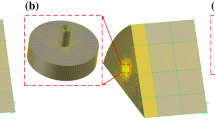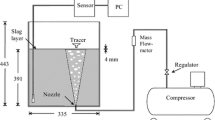Abstract
The intensity of mixing in a molten metal bath stirred by bottom gas injection can be represented by the mixing time. According to previous water model experiments, the mixing time is known to be dependent on the operational variables such as the bath diameter, bath depth, location of a bottom nozzle, and gas flow rate. It is not easy to control the former three variables during processing, and the dependence of the mixing time on the gas flow rate is weak. In this study, the possibility of changing the mixing time drastically due to the control of the surface flow in the bath is examined. Three kinds of boundary conditions were imposed on the bath surface, and the relation between the fluid flow phenomena resulting from the surface flow control and the mixing time was investigated. The mixing time was found to be significantly influenced by the surface flow control. In particular, when the surface flow was suppressed by bringing a circular cylinder into contact with the bath surface, the mixing time became very long.
Similar content being viewed by others
References
K. Nakanishi, T. Fujii, and J. Szekely: Ironmaking and Steelmaking, 1975, vol. 2, pp. 193–97.
K. Nakanishi, K. Saito, T. Nozaki, Y. Kato, K. Suzuki, and T. Emi: Proc. Steelmaking Conf., 1982, vol. 65, p. 101.
S. Asai, T. Okamoto, J.C. He, and I. Muchi: Trans. Iron Steel Inst. Jpn., 1983, vol. 23, pp. 43–50.
U.P. Sinha and M.J. McNallan: Metall. Trans. B, 1985, vol. 16B, pp. 850–53.
T. Stapurewicz and N.J. Themelis: Can. Metall. Q., 1987, vol. 26, pp. 123–28.
G.G. Krishnamurthy, S.P. Mehrotra, and A. Ghosh: Metall. Trans. B, 1988, vol. 19B, pp. 839–50.
J. Mietz and F. Oeters: Steel Res., 1989, vol. 60, pp. 387–94.
D. Mazumdar and R.I.L. Guthrie: Iron Steel Inst. Jpn. Int., 1995, vol. 35, pp. 1–20.
M. Iguchi, S. Hosohara, T. Kondoh, Y. Itoh, and Z. Morita: Iron Steel Inst. Jpn. Int., 1994, vol. 34, pp. 330–37.
M. Iguchi, T. Kondoh, and T. Uemura: Int. J. Multiphase Flow, 1994, vol. 20, pp. 753–62.
M. Iguchi, O.J. Ilegbusi, H. Ueda, T. Kuranaga, and Z. Morita: Metall. Mater. Trans. B, 1996, vol. 27B, pp. 37–41.
M. Iguchi, S. Hosohara, T. Koga, R. Yamaguchi, and Z. Morita: Iron Steel Inst. Jpn. Int., 1993, vol. 33, pp. 1037–44.
M. Iguchi, K. Nakamura, and R. Tsujino: Metall. Mater. Trans. B, 1998, vol. 29B, pp. 569–75.
D. Mazumdar, H. Nakajima, and R.I.L. Guthrie: Metall. Trans. B, 1988, vol. 19B, pp. 507–11.
Author information
Authors and Affiliations
Rights and permissions
About this article
Cite this article
Iguchi, M., Tsujino, R., Nakamura, KI. et al. Effects of surface flow control on fluid flow phenomena and mixing time in a bottom blown bath. Metall Mater Trans B 30, 631–637 (1999). https://doi.org/10.1007/s11663-999-0024-7
Received:
Issue Date:
DOI: https://doi.org/10.1007/s11663-999-0024-7




